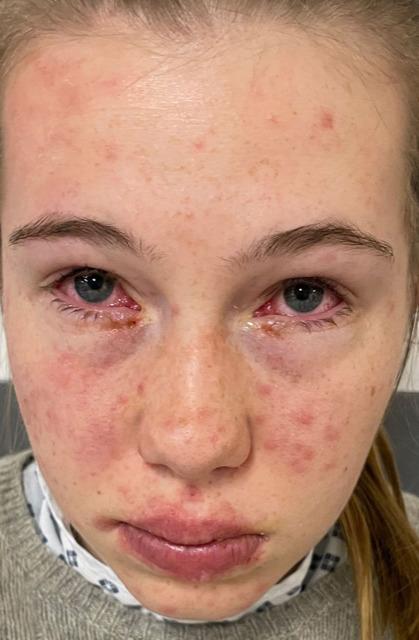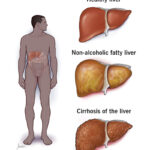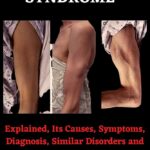Stevens-Johnson syndrome (SJS) is a rare, acute, and potentially fatal skin and mucous membrane disorder characterized by widespread epidermal necrosis and detachment. Often triggered by medications or infections, SJS presents with flu-like symptoms followed by painful red or purplish rash that blisters and peels off, affecting both the skin and internal mucosa.
SJS is considered a medical emergency requiring hospitalization and may progress to toxic epidermal necrolysis (TEN) when skin detachment exceeds 30% of the body surface area.

Causes and Risk Factors of Stevens-Johnson Syndrome
The most common causes of SJS include hypersensitivity reactions to certain medications and, less frequently, infections.
1. Drug-Induced Stevens-Johnson Syndrome
Medications are the leading cause, particularly within the first 1–3 weeks of initiation. High-risk drugs include:
- Antibiotics: Sulfonamides (e.g., sulfamethoxazole), aminopenicillins
- Antiepileptics: Carbamazepine, lamotrigine, phenytoin
- NSAIDs: Especially oxicam derivatives
- Allopurinol
- Antiretrovirals
2. Infectious Triggers
SJS can result from:
- Mycoplasma pneumoniae
- Herpes simplex virus
- Hepatitis
- HIV
- Influenza virus
3. Genetic Susceptibility
Certain genetic factors increase the risk:
- HLA-B*1502: Associated with carbamazepine-induced SJS in Asian populations
- HLA-A*3101: Linked to allopurinol reactions
Clinical Presentation of Stevens-Johnson Syndrome
Early Symptoms
- Fever, malaise, sore throat
- Burning eyes
- Flu-like illness 1–3 days before skin symptoms
Cutaneous Manifestations
- Painful erythematous or purpuric macules
- Rapidly progressing to target lesions
- Blistering and full-thickness epidermal detachment
- Positive Nikolsky sign: Skin sloughs off with lateral pressure
Mucosal Involvement
- Oral ulcers, erosions
- Conjunctivitis and corneal ulceration
- Genital and anal mucosal lesions
Diagnosis of Stevens-Johnson Syndrome
Clinical Evaluation
Diagnosis is primarily clinical, based on:
- Extent of skin detachment (<10% BSA for SJS, >30% for TEN)
- Mucosal involvement
- Recent exposure to high-risk medications or infections
Diagnostic Tests
- Skin biopsy: Shows full-thickness epidermal necrosis and minimal inflammation
- Blood tests: CBC, liver enzymes, electrolytes, and inflammatory markers
- Cultures: Rule out infections
- SCORTEN scale: Prognostic scoring system assessing mortality risk
Differential Diagnosis
SJS must be distinguished from other severe dermatologic conditions:
- Toxic Epidermal Necrolysis (TEN)
- Erythema Multiforme Major
- Pemphigus vulgaris
- Bullous pemphigoid
- Staphylococcal Scalded Skin Syndrome (SSSS)
Management and Treatment of SJS
Immediate Steps
- Immediate cessation of the causative drug
- Transfer to a burn unit or ICU
- Supportive care is the cornerstone of treatment
Supportive Measures
- Fluid and electrolyte management
- Nutritional support via feeding tube if needed
- Wound care using non-adherent dressings
- Pain control and sedation
- Monitoring for sepsis, organ failure, and ocular complications
Pharmacologic Interventions
- IV immunoglobulin (IVIG): May block Fas-mediated apoptosis
- Systemic corticosteroids: Controversial but sometimes used in early stages
- Cyclosporine or TNF-alpha inhibitors: Emerging options in severe cases
- Antibiotics: Only if secondary infection is present
Prognosis and Complications
The severity of SJS and its progression to TEN significantly affect outcomes. The mortality rate for SJS ranges from 5–10%, while TEN may exceed 30%.
Long-Term Complications
- Ocular sequelae: Chronic dry eyes, blindness, symblepharon
- Respiratory tract damage
- Esophageal strictures
- Skin pigmentation changes and scarring
- Psychological trauma
Prevention and Risk Mitigation
Genetic Screening
In high-risk populations (especially Southeast Asians), screening for HLA-B*1502 is advised before prescribing carbamazepine or related drugs.
Medication Vigilance
- Review drug history before initiating high-risk medications
- Educate patients on early symptoms
- Avoid rechallenge with the offending agent
Stevens-Johnson syndrome represents one of the most serious dermatological emergencies, necessitating rapid diagnosis, drug withdrawal, and intensive care. By understanding the early warning signs, high-risk medications, and effective supportive strategies, we can significantly reduce both the immediate and long-term impacts of this devastating condition.

